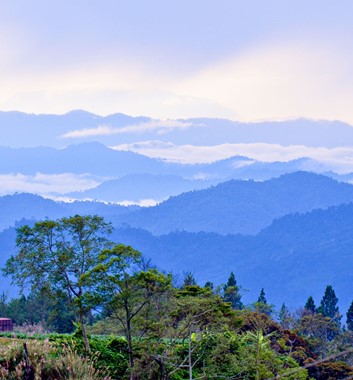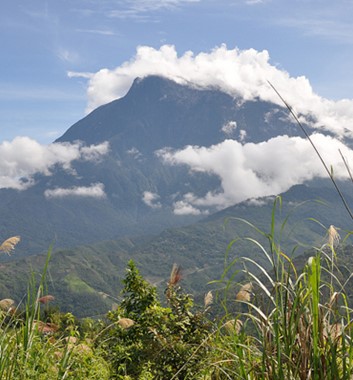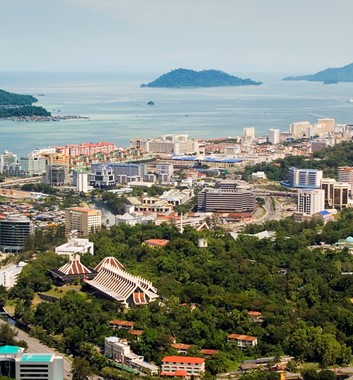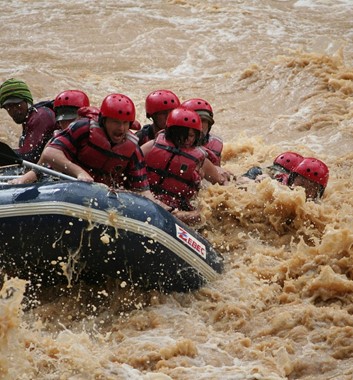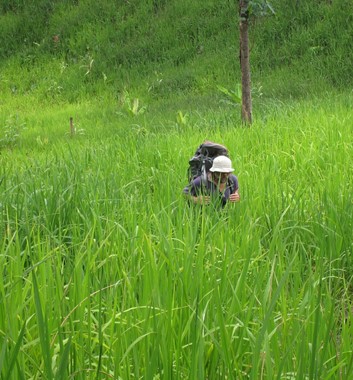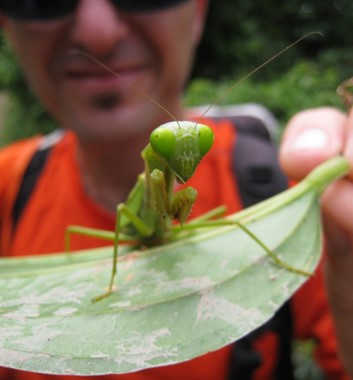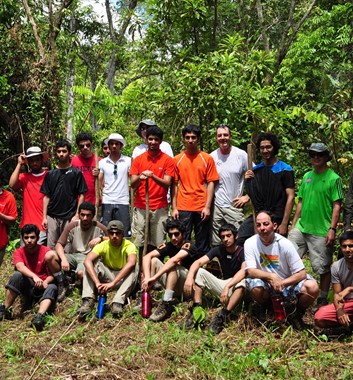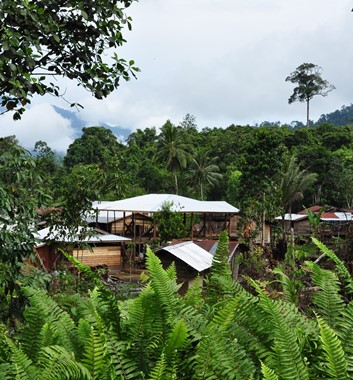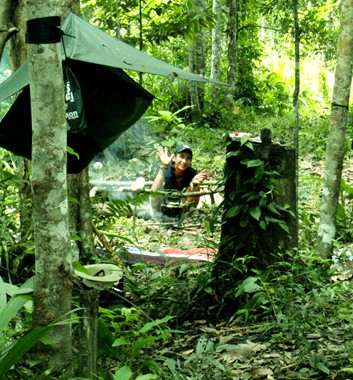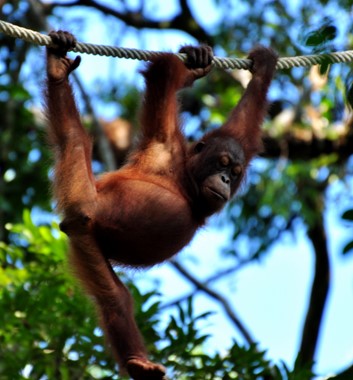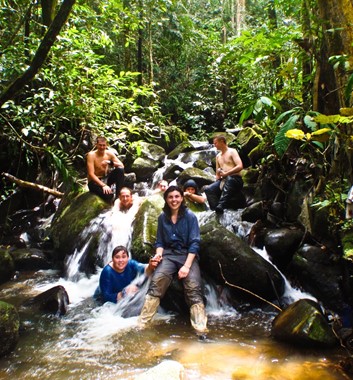Overview
School Adventures in Borneo
We provide a bespoke flexible package for school groups to visit Sabah and Sarawak in Borneo for adventure, culture and travel. Generally school trips last between two and four weeks, and group size is normally between ten and twenty although any visits to the Penan area in Sarawak are restricted to twelve because of the number of seats in the light aircraft.
Activities can either be all in the northern state of Sabah or the southern state of Sarawak, or both. Most places are reached by light aircraft and there is a very good network or domestic flights with either Malaysian Airlines or Air Asia.
The most popular activities in each state for school groups are
Sarawak:
Visiting the Penan tribe in the interior and learning about jungle life and skills from the tribesmen (like blowpipe making), about life for these indigenous people (religion, education, economy, hunting) and the effects of logging on the rainforest. People can learn about sleeping in hammocks and how to make shelters, go hunting, spend time with the blowpipe maker and visit re-planted areas which had been logged and see nearby natural sights like huge waterfalls. The Penan will be the guides.
Penan trip 2017 - Sarawak - HD1080 from Adventure Alternative on Vimeo.
Visiting an Iban community and staying at their centre which we helped to develop, and going on a host of activities including rafting and wildlife safaris in the Batang Ai reserve, and visiting the Semenggoh orangutan sanctuary.
Visiting the world famous Mulu Caves and exploring the show caves to see the daily bat exodus, and also the adventure caves. With enough advance notice there is also a chance to trek deeper into the forest and stay overnight in a remote lodge to enjoy the feeling of remoteness and perhaps see the famous Mulu pinnacles and Mount Mulu from a distance.
Sabah:
Jungle trekking and staying in village homestays in the Crocker Hills of Sabah, learning about local foods and life up in the hills for the communities there.
Climbing either Mount Trusmadi as a mountain challenge which involves wild camping in the jungle, or Mount Kinabalu which is much busier and more organised.
Wildlife safaris in Sabah on the Kinabatangan river, staying in a combination of local homestays or riverside lodges and jungle camps. This is easily combined with visiting the famous Sepilok orangutan reserve and the sun bear conservation centre while staying in a nearby cloudforest lodge.
Staying in our own jungle camp in the forests on the slopes of Mount Kinabalu called Lupa Masa, meaning 'forgotten time', and going on night time 'bug safaris', river rafting, visiting the Poring Hot Springs, seeing the tea plantations, relaxing in the waterfalls and sleeping in hammocks or tree platforms.
More about visiting the Penan tribe
A trek into the rainforest to stay with the Penan is an experience never to be forgotten. The Penan tribe have only relatively recently begun taking in visitors and we are the only organisation going there, so this promises to be a unique and rewarding cultural exchange. Learning the lore of the jungle is a very special opportunity, but we do not wish to have any negative impact on the people who live in and off the jungle. We need to be respectful and careful of our ‘footprint’.
The Penan way of life is something we might only ever see on television, or in a magazine, but to physically be there and sleep a night underneath the jungle canopy in a hammock with a giant leaf covering you, and with the cacophony of jungle sounds as your music, is the stuff of dreams.
However as we all know the forest around the Penan people is gradually being logged, so it is a salutary experience to see these open areas of devastation, the spread of palm oil plantations and the efforts of the villagers to re-seed logged areas with new trees. This was a project that was initially funded by our charity Moving Mountains, and visitors can still see the tree nurseries and visit the areas which were replanted some years ago and are now becoming primary forest again.
The Penan achieved a significant victory for the protection of their land lately, and now there is a Penan Peace Park of some 130,000 acres which has been put under protective status by the Malaysian Government.
Borneo adventure staff
We use our own local guides in Borneo and also Western guides who have all worked and proven themselves to us over the years. Our western guides have years of experience organising teams in Borneo and can be trusted to not only provide a fascinating and fun insight into the various locations but also to ensure that you are safe and well looked after. We fully comply with the British Standard 8848 for overseas youth expeditions and all our trips are 'stress tested' against risk assessments.
Borneo parks and life in the jungle
Sarawak’s rainforest is a nature lover’s paradise and boasts of one of the most diverse ecosystems in the world. The rainforest is a safe haven for uncountable species of flora and fauna as well as being a sanctuary to various species of wild animals, including the incredibly shy silvered leaf monkey which lives on flower and fruits. This expedition not only allows a unique opportunity to witness some of this rare and endangered flora and fauna, but also some of the hundreds of different species of mammals, birds, snakes, lizards and amphibians. With expert tuition this is an enjoyable and memorable experience, especially in Sarawak where you can meet the local people who hunt and make blow pipes and keep the old traditions alive.
What Kind of Kit is Required?
Then jungle is a special environment, in order to thrive here, certain gear items are needed. Check out our Borneo Kit List overview page for more.
Borneo School Adventure - fitness and terrain
The expedition element for the Borneo school adventure is moderately demanding with some long days of sustained walking with a backpack. The effects of heat and humidity will also further tax your body. You will enjoy the trip all the more if you are in good physical shape having exercised regularly over at least the 6 months leading up to the trip.
You do need to be in good health as we will spend some time in locations that are many hours from professional medical care. Any pre-existing medical or dental conditions should be fully appraised by a doctor and their nature fully disclosed to your insurer and to ourselves.
Rainforest
The rainforest is actually a very clean and pure place to visit. The canopy offers excellent shade from the intense sun and traps moisture, however it can be very humid and a lot of water will need to be continually drunk. We travel using trails and the rivers which have been the jungle arteries for the local native residents for hundreds of years. It is very unlikely that you’ll be off the beaten track with a machete. Sometimes the paths can be muddy and slippery, and there are logs to clamber over, streams to cross and it is always up and down.
Movement in the jungle is generally very slow, about 10km maximum per day, and it is easy to feel exhausted after just a few hours. Keeping rehydrated is paramount and looking out for natural dangers such as thorns or tripping over moss-covered rocks. It is unlikely you will see much wildlife while on the move, except for birds but if you keep very still and quiet you will find the jungle is full of wildlife! Just a short while spent listening and watching carefully will yield some tremendous sights of indigenous mammals like the red leaf monkey. Moving through the jungle you will begin to see how a completely green and seemingly impenetrable terrain is actually filled with ‘signposts’ and guides; the lore of the jungle is what you have come to experience.
Crossing streams is an ideal time to have a quick cooling down in the water, get some liquid on board and take a rest, however some of the streams become minor cataracts after a heavy downpour. You should buy locally made jungle shoes to walk in, these are rubber and they have moulded studs for grip on the muddy ground, some also have holes in them for aeration.
Mt Kinabalu
Mount Kinabalu is an oval-shaped granite dome which arose from volcanic and tectonic movements about 1.5 million years ago, which was followed by glacial erosion during the Ice Age, and this accounts for the smooth rock surface. The lower slopes are steep, but the path is well trodden with regular water stops and many wooden steps that meander ever upwards. There is no doubt that it seems never-ending, especially in the midday heat! As you trek through the vegetation zones, there are many view points to enjoy and lots of stops. A lot of people climb the mountain, so you are rarely alone, although you do feel very jealous of those coming down.
Above the hut at Laban Rata you pass onto the high plateau, from vegetation to rock, and the terrain is altogether different. It is utterly bare of plant life, just miles of granite and many peaks and spires. It is easy to walk across, except when it is raining. When the surface is wet you have to be very careful of slipping. When the cloud comes down it is very easy to get lost up on this plateau, so be very aware of the weather and stick close to your guides.
Coming down the mountain can be difficult too, with hundreds of steps to negotiate until your knees are complaining and your feet are sore. Again, it seems never-ending, but at least you are now passing people on their way up who are feeling jealous of you!
Camps used on the Borneo school adventure
In Kuching, near Sepilok and Kota Kinabalu we stay in small, family run guest houses. This are very comfortable with dormitory style or twin rooms, showers and western-style toilets. The jungle camp by the beach near Kuching is basic but comfortable. Nights are spent in simple jungle huts by the beach.
During our trek to the Penan area we will be using fly camps, and the expedition will be travelling self-sufficiently, using hammocks en route. This is one of the great experiences of the trip; sleeping under the forest canopy listening to the jungle around. In the villages we will be staying in home stays with the local Penan people. In the villages the people live in homes built from the jungle. Life in the villages follows an ancient rhythm of hunting, foraging, gathering and socialising. The pace is slow and the priority is the community itself. The house are comfortable and we will receive a very warm and friendly welcome. Some houses have bucket showers, but on some occasions baths and showers are taken in rivers and streams. Most of the houses have long drop toilets. Our home stays in the Bilit and Abai villages in Sabah will be a similar style to the homestays in the Penan area.
Accommodation at Lupa Masa is comfortable; with stretcher-type hammocks in traditional “sulaps”. In the bathrooms there are bucket showers, or an option which many guests prefer is to shower in one of the beautiful waterfalls or streams surrounding the lodge. Toilets are squat toilets. There is a kitchen and dining area, power supplied by the water and some lovely places to just sit and relax and watch the wildlife.
Accommodation on Mt Kinabalu is in the Mesilau Resort and Laban Rata Hut and Sayat Sayat Hut, depending on which has the availability at the time. Mesilau is very comfortable with showers and western style toilets. Laban Rata is a comfortable hut with dormitory style bedrooms, toilets and showers. Sayat Sayat is a higher hut, just above the forest line with amazing views and options for a mountain hut or tents.
On the beach accommodation is in dormitory style bedrooms and is basic but comfortable.
Experience needed for the Borneo school adventure
You do not need to have any previous experience for this expedition as our guides will show you everything you need to know. The Penan people will show you how to live off the jungle, how to make a plate out of a leaf for example and how to build hammocks, and how to travel efficiently in their environment.
Clearly this trip is quite challenging if you are expecting modern amenities, since there are none in the jungle, so the trip will require patience, teamwork and a willingness to work with Mother Nature! Sometimes the heat and humidity can be debilitating, and sap even the most positive of minds. Mental preparation and an open mind are essential.
The mountain challenge is a non-technical trek to climb Mount Kinabalu alongside the various other elements of the trip. You will need to be reasonably fit and any regular hill walker will find this expedition within his or her capabilities. A training programme should include regular hill walking with a small pack of around 5-10kgs, and regular visits to the gym or the swimming pool for the final two months before departure.
Adventure Alternative support
Adventure Alternative supplies excellent guides and where appropriate local porters, plus of course all the villagers who will be supporting you. Our leader has a lot experience of travelling in Borneo and will manage the situations and help teach you any skills which you may not already have, but in the village there will be no better support or teacher than the local people.
In the Penan area the expedition is self-sufficient and the leader will have satellite communication and a group first aid/jungle repair kit but there is no doubt that this trip requires common sense and teamwork. Getting out of the area in the event of an accident or emergency will mean doing the same journey in, in order to get out. This means potentially carrying somebody to the 4x4, and then getting to the light aircraft as soon as possible.
On Mount Kinabalu we will have porters to help with the bags, and also any tents, food, stoves and fuel. You will have to carry some personal clothing plus water, c
Dates & Bookings
Cost
School Expedition to Borneo cost is variable depending on the specific itinerary agreed but generally the inclusions and exclusions are as follows. We will agree the cost with each school and put the private itinerary on the Dates and Bookings tab. When you click to book it will take you to the booking process where the price is shown.
Our prices are land only, but we also include internal flights as an option.
INCLUDES
- Expedition guide and venture leader
- Organisation and staffing from our office and the local Penan people, covering all of their costs for guiding, translating and hosting visitors in their homes
- All food and meals during the trip, which includes any food eaten in homes in the village
- All accommodation as stated in the itinerary
- Longboats in the Penan area and all other river transport
- Internal flights
- 4x4 transport in the Penan area and all other road transport
- Jungle survival course
- Entry to Sepilok and Semenggoh Wildlife Centres
EXCLUDES
- International airfare to Borneo, via Kuala Lumpur
- Internal flights to and from the start points in Borneo
- Vaccinations and anti-malarials required
- Travel insurance
- Personal expenses
A deposit of £100 is required on booking to secure your place and we ask that the remaining balance (trip price minus the deposit) is paid in full 6 weeks prior to your departure.
Travel Insurance - you will need travel insurance for this trip. Normal holiday travel insurance is adequate as long as it covers trekking and rafting grades 1-3. We advise you to get this insurance early on, so that if you have to make a late cancellation for some reason then you will get all your money back.
LOCAL PROVIDER
Our local provider is Adventure Alternative Borneo. Adventure Alternative Borneo complies with UK tourism standards. Where we do use providers such as hostel and guesthouse owners and homestays these are people our Adventure Alternative Borneo staff have known for years, and spent time with to build up the trust between both parties.
Fitness
Borneo School Adventure - fitness and terrain
The expedition element for the Borneo school adventure is moderately demanding with some long days of sustained walking with a backpack. The effects of heat and humidity will also further tax your body. You will enjoy the trip all the more if you are in good physical shape having exercised regularly over at least the 6 months leading up to the trip.
You do need to be in good health as we will spend some time in locations that are many hours from professional medical care. Any pre-existing medical or dental conditions should be fully appraised by a doctor and their nature fully disclosed to your insurer and to ourselves.
Rainforest
The rainforest is actually a very clean and pure place to visit. The canopy offers excellent shade from the intense sun and traps moisture, however it can be very humid and a lot of water will need to be continually drunk. We travel using trails and the rivers which have been the jungle arteries for the local native residents for hundreds of years. It is very unlikely that you’ll be off the beaten track with a machete. Sometimes the paths can be muddy and slippery, and there are logs to clamber over, streams to cross and it is always up and down.
Movement in the jungle is generally very slow, about 10km maximum per day, and it is easy to feel exhausted after just a few hours. Keeping rehydrated is paramount and looking out for natural dangers such as thorns or tripping over moss-covered rocks. It is unlikely you will see much wildlife while on the move, except for birds but if you keep very still and quiet you will find the jungle is full of wildlife! Just a short while spent listening and watching carefully will yield some tremendous sights of indigenous mammals like the red leaf monkey. Moving through the jungle you will begin to see how a completely green and seemingly impenetrable terrain is actually filled with ‘signposts’ and guides; the lore of the jungle is what you have come to experience.
Crossing streams is an ideal time to have a quick cooling down in the water, get some liquid on board and take a rest, however some of the streams become minor cataracts after a heavy downpour. You should buy locally made jungle shoes to walk in, these are rubber and they have moulded studs for grip on the muddy ground, some also have holes in them for aeration.
Mt Kinabalu
Mount Kinabalu is an oval-shaped granite dome which arose from volcanic and tectonic movements about 1.5 million years ago, which was followed by glacial erosion during the Ice Age, and this accounts for the smooth rock surface. The lower slopes are steep, but the path is well trodden with regular water stops and many wooden steps that meander ever upwards. There is no doubt that it seems never-ending, especially in the midday heat! As you trek through the vegetation zones, there are many view points to enjoy and lots of stops. A lot of people climb the mountain, so you are rarely alone, although you do feel very jealous of those coming down.
Above the hut at Laban Rata you pass onto the high plateau, from vegetation to rock, and the terrain is altogether different. It is utterly bare of plant life, just miles of granite and many peaks and spires. It is easy to walk across, except when it is raining. When the surface is wet you have to be very careful of slipping. When the cloud comes down it is very easy to get lost up on this plateau, so be very aware of the weather and stick close to your guides.
Coming down the mountain can be difficult too, with hundreds of steps to negotiate until your knees are complaining and your feet are sore. Again, it seems never-ending, but at least you are now passing people on their way up who are feeling jealous of you!
Camps used on the Borneo school adventure
In Kuching, near Sepilok and Kota Kinabalu we stay in small, family run guest houses. This are very comfortable with dormitory style or twin rooms, showers and western-style toilets. The jungle camp by the beach near Kuching is basic but comfortable. Nights are spent in simple jungle huts by the beach.
During our trek to the Penan area we will be using fly camps, and the expedition will be travelling self-sufficiently, using hammocks en route. This is one of the great experiences of the trip; sleeping under the forest canopy listening to the jungle around. In the villages we will be staying in home stays with the local Penan people. In the villages the people live in homes built from the jungle. Life in the villages follows an ancient rhythm of hunting, foraging, gathering and socialising. The pace is slow and the priority is the community itself. The house are comfortable and we will receive a very warm and friendly welcome. Some houses have bucket showers, but on some occasions baths and showers are taken in rivers and streams. Most of the houses have long drop toilets. Our home stays in the Bilit and Abai villages in Sabah will be a similar style to the homestays in the Penan area.
Accommodation at Lupa Masa is comfortable; with stretcher-type hammocks in traditional “sulaps”. In the bathrooms there are bucket showers, or an option which many guests prefer is to shower in one of the beautiful waterfalls or streams surrounding the lodge. Toilets are squat toilets. There is a kitchen and dining area, power supplied by the water and some lovely places to just sit and relax and watch the wildlife.
Accommodation on Mt Kinabalu is in the Mesilau Resort and Laban Rata Hut and Sayat Sayat Hut, depending on which has the availability at the time. Mesilau is very comfortable with showers and western style toilets. Laban Rata is a comfortable hut with dormitory style bedrooms, toilets and showers. Sayat Sayat is a higher hut, just above the forest line with amazing views and options for a mountain hut or tents.
On the beach accommodation is in dormitory style bedrooms and is basic but comfortable.
Experience needed for the Borneo school adventure
You do not need to have any previous experience for this expedition as our guides will show you everything you need to know. The Penan people will show you how to live off the jungle, how to make a plate out of a leaf for example and how to build hammocks, and how to travel efficiently in their environment.
Clearly this trip is quite challenging if you are expecting modern amenities, since there are none in the jungle, so the trip will require patience, teamwork and a willingness to work with Mother Nature! Sometimes the heat and humidity can be debilitating, and sap even the most positive of minds. Mental preparation and an open mind are essential.
The mountain challenge is a non-technical trek to climb Mount Kinabalu alongside the various other elements of the trip. You will need to be reasonably fit and any regular hill walker will find this expedition within his or her capabilities. A training programme should include regular hill walking with a small pack of around 5-10kgs, and regular visits to the gym or the swimming pool for the final two months before departure.
Adventure Alternative support
Adventure Alternative supplies excellent guides and where appropriate local porters, plus of course all the villagers who will be supporting you. Our leader has a lot experience of travelling in Borneo and will manage the situations and help teach you any skills which you may not already have, but in the village there will be no better support or teacher than the local people.
In the Penan area the expedition is self-sufficient and the leader will have satellite communication and a group first aid/jungle repair kit but there is no doubt that this trip requires common sense and teamwork. Getting out of the area in the event of an accident or emergency will mean doing the same journey in, in order to get out. This means potentially carrying somebody to the 4x4, and then getting to the light aircraft as soon as possible.
On Mount Kinabalu we will have porters to help with the bags, and also any tents, food, stoves and fuel. You will have to carry some personal clothing plus water, camera and sundry items amounting to no more than about 8 kgs.
Kit List
Borneo school adventure kit list
- Rucksack with waterproof liner for the jungle and mountain section (there is a 10kg small plane allowance on internal flights)
- Duffle bag for flying and keeping everything inside
- Dry bags to keep clothes in
- Sleeping bag liner made of cotton or silk
- Sleeping clothes, light and long sleeved (cotton)
- Sweater or light weight fleece as it can be cold at night
- Trekking clothes - either lightweight long trousers and shirt or t-shirt and shorts, plus a change of clothes (quick drying)
- Rubber shoes which can be bought in Borneo
- Sandals
- Leech socks
- Trekking socks
- Underwear and cycling shorts which are good for trekking in
- Head torch
- Sun hat, sun glasses
- Ear plugs (forest is noisy)
- Penknife and small repair kit, tape, cable ties etc
- Bowl, mug, plastic cutlery, penknife, cable ties and small repair kit
- Light rope to use as a drying line for wet clothes
- Water bottle
- AquaPure water treatment bottle (0.7 litre) or water purification tablets
- Swimming stuff /shorts
- Camera (and waterproof bag or case), spare battery/memory card
- Personal medications
- Washing gear, toothpaste, soap (environmentally friendly variety), lightweight towel, toilet paper in plastic bag
- First aid kit, sun cream, talc, mosquito spray and anti-malarial tablets
- Hammock (can be rented in borneo)
- General clothes for travelling and sightseeing (lightweight, long sleeved)
Jungle travel for the Borneo school adventure
Travel light and compact in the jungle. The large holdall will carry everything on international travel and can be used to store anything that is not going in to the jungle, but once you start the journey into Sarawak you don't need much. Normally you have two sets of clothes, a day set which gets very damp from the humidity, and a dry set for the evening. At night you sleep in hammocks with a cotton sheet and a light sleeping bag, wearing a t-shirt.
In the jungle you have to contend with the heat and humidity, so there are lots of water stops and plenty of opportunity to jump in streams and cool down. Insects are attracted to the sweat so wear lightweight long sleeved clothing and shorts, and no cotton underwear or anything which might chafe. Insect repellent is useful and you may want to consider a repellent for clothing. Leech socks are also useful, basically knee length socks that are very smooth so the leech cannot latch on as you walk past. They dangle of grass stems and branches and wait for you to brush by. They are not painful, in fact you have no idea they have landed on you until you see the blood. Apart from being a bit gruesome, dealing with leeches is not a big problem. Most people find it takes time to acclimatise to the humidity in the forest, but once this has happened after a few days most people love the experience of being under the canopy and travelling so light.
There are many brands/types of water purification bottles and you can get them in good outdoor/travel shops and online shops. The Aquapure Traveller Bottle or something similar will work well in Borneo. Actually if you are using running water there are few problems to worry about, the water is from the rain and it's lovely and fresh. Sieving the water is useful in case of bits, and by all means use the chlorinated tablets that are common, or a water filter.
The two main brand names for suitable hammocks are 'Hennessy Hammocks' and 'Nomad Travel' though if you end up getting the a Nomad hammock then remember that you will also need to get a mosquito net too, all suitable Hennessy hammocks have a mosquito net built in. A Nomad hammock and mosquito net should work out much cheaper than a Hennessy hammock. We do rent them out to people on trips, or you can buy one for yourself online.
Clothing should be lightweight cotton or synthetic (bear in mind that cotton is slow drying, a synthetic fabric like polyester or nylon will be much quicker drying) though no matter how quick drying your clothes are you should expect them to be damp at best throughout your time in the jungle!
Mount Kinabalu
This is a three day trek up and down a great mountain which is actually a batholith (a huge mound of granite) rising out of the oldest rainforest in the world. There are very easy paths to follow although they do go on and on! The walk takes you through the lower forest and up into the montane or alpine style forest, and if you're lucky and quiet you can see and hear a lot of wildlife. The paths are big rocky trails which can be pretty tiring on the leg muscles and knees, so it's important to stretch afterwards or else put up with a bit of hobbling the next day! The heat can be intense, so there are lots of water stops at the rest stations which are called pondoks. You'll meet a lot of people going up and down, it's a very popular activity for Malaysians and they come from far and wide. Wear good trekking boots, shorts, Tshirts and shirts and definetely take warm clothing for the night and waterproof jackets for when it rains. When it rains, it absolutely pours down. Tropical downpours are pretty common here so make sure everything is in dry bags inside your rucksack.
You will need your sleeping bag plus the liner to keep warm, and sleeping mats only if we are using tents near the Sayat Sayat hut, but you can rent them locally. For the summit day itself you are up in the dark so bring a good headtorch, and negotiating the open rocky plateaux to get to the summit. It can be cold so warm hat, gloves, fleece and waterproof jacket are all important. You only need one of everything really because it's just a three day trek up and down, but make sure you keep it dry!
Beach and other places
This is a tropical paradise so bring swimming stuff, sandals or flipflops, towel, sunglasses and cream, beach gear and Tshirt for swimming in. It's really easy to get a sunburnt back while snorkelling over coral reefs. Some people like to bring light neoprene gloves and socks for the snorkelling just in case you step on something or touch something that is sharp or stings.
For sightseeing and just being around, keep it simple and light and remember that the sun can do a lot of damage to our fair skin.
Personal Medical Kit suggestion
Paracetamol
Ibuprofen
Antiseptic Wipes
Adhesive Plasters
Blister Plasters
Zinc Tape
Insect Repellent
Antihistamine tablets
Sunblock Cream
Water Purification Tablets
Rehydration Sachets
Personal Medication as required:
eg. Anti-Malarials, Asthma Inhalers, Insulin, Epi-Pen etc
Possible Additional Personal First Aid Items
Lip Salve
Throat Lozenges
Latex gloves
Crepe Bandage
Hydrocortisone Cream
Prochlorperazine tablets (for sickness/nausea)
Ciprofloxacin tablets (general antibiotic; prescription required)
Acetazolamide tablets (altitude prophylactic; prescription required)
Note: you must check with your GP for your personal suitability to all medicines and their possible side effects and interactions. Please inform us of the details of all regular medication that you intend to use though the course of your trip and any relevant allergies and medical history related to them. You also need to check the requirements and regulations of the airline and all countries visited in relation to medications. For example; laws governing transport of some pain control medication and the need keep insulin at a suitable temperature, ie not in the cargo hold.
Why Us
Borneo school adventure - why us?
- We have our own local subsidiary company in Borneo and employ local guides and staff to ensure that revenue is retained in the host nation.
- We have built up a great partnership and trust with the Penan tribe which has taken years of patience. We do not simply turn up, this trip happens only once a year and is at the request of the villagers. They love our visits and they love sharing their lives with us, and the programme has largely been designed by them. We really want them to benefit from tourism, and they are eager to attract people to their home so that others can see it's fragility and the importance of wanting to protect it.
Photos
Choose a scheduled date or contact us to set up private dates or a bespoke itinerary. The minimum deposit is £100.00 and the balance is due four weeks before travel.
- Duration 4 weeks
- Numbers 5-12
- Max Altitude 4095m
- Comfort Camping, homestay
- Challenge Moderate
- Borneo Preparation
- Borneo Health and Comfort
- Borneo Volunteering Projects
- Borneo clothing advice
- Borneo Culture Tips
- Lupa Masa Jungle Camp
- Borneo Community Benefits
- Volunteer preparation
- Travel Insurance
- Volunteer fundraising guide
- Avoiding malaria
- Travel vaccinations
- When is the best time to visit Borneo?
- Danum Valley - Trip Add-on
- Penan Tribe Trek - Trip Add-on
- Mount Mulu - Trip Add-on
- Kawag Nature Lodge - Trip Add-on
- Borneo Rainforest Lodge - Trip Add-on
- Hibiscus Beach Retreat - Trip Add-on
- KK's Hotel Sixty-3 Add-on
- Big Fin Beach Resort - Trip Add-on
- Sepilok / Kinabatangan River - Trip Add



